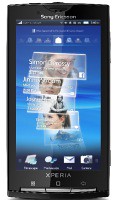Sony Ericsson Xperia X10

Sony Ericsson has taken a while to come up with an Android-based handset, and the Xperia X10, it has to be said at the outset, is probably not the offering to tempt business users. A forthcoming variant, the tiny Xperia X10 mini pro might appeal more, as it has a slide-out QWERTY keyboard while sharing elements of the Xperia X10's somewhat quirky user interface.
The Xperia X10 is absolutely vast with a 4in. 480-by-854 -pixel screen sitting in a chassis that measures 119mm by 63mm by 13mm. It's not the handset to slide into a slimline pocket easily. It has a slightly boxy chassis design which won't appeal to everyone.

The 1GHz Qualcomm Snapdragon processor is par for the course for today's high-end smartphones, and with 1GB of internal memory and an 8GB microSD card included alongside the usual Android fare of 3G, Wi-Fi and GPS there's not a lot wrong with the base specifications.
Sony Ericsson throws in an 8.1-megapixel camera that acquits itself well, but then kicks itself in the shins by using Android 1.6. This is just too far behind the times. Crucially for business users, there is no native support for Exchange in Android 1.6, although Sony Ericsson has added this via third-party applications.
But it is Sony Ericsson's method of skinning Android that will make or break this handset. The skinning system relies on two elements that Sony Ericsson calls Mediascape and Timescape.
Mediascape is an integrated viewing system for music, video and photos that will grab information from the web from your Picasa and Facebook libraries. It looks good, and it's nice to have online and offline data in one place, but it probably has little appeal for business users.
Timescape has more potential. It brings together communications from a range of sources including SMS, email and Twitter into one scrolling listing. It adds in songs you've listened to recently and recently viewed photos. To see classes of data individually you sweep horizontally. It's just a viewer though: for example, to see a message in full and reply to it, you need to get involved in screen tapping to open applications.
It all looks very enticing, and there is a real 'wow' factor involved in using it at first, but Timescape turns out to be disappointing in everyday use.
Inevitably the entire user interface must stand up against HTC's superb Sense, which is so much more flexible. For example, you can choose to see Timescape as your main screen. Do this and you have just the one main screen. To access the three screens that are native to Android, and which can be populated with Android widgets, you need to have Timescape as an on-screen option. It feels like a bit of a Hobson's choice.
There are some other irritations. The absence of pinch-to-zoom makes web browsing, which should be a treat on that large screen, feel slightly hamstrung. Also, the large size of the device made it impossible for me to reach across to use it one-handed.
The Xperia X10 does not feel like the well thought-out smartphone it could be, and from a business point of view there's little to recommend it over other Android offerings. I await the X10 mini pro with interest — maybe that will be a more appropriate device for business users.
Sandra Vogel